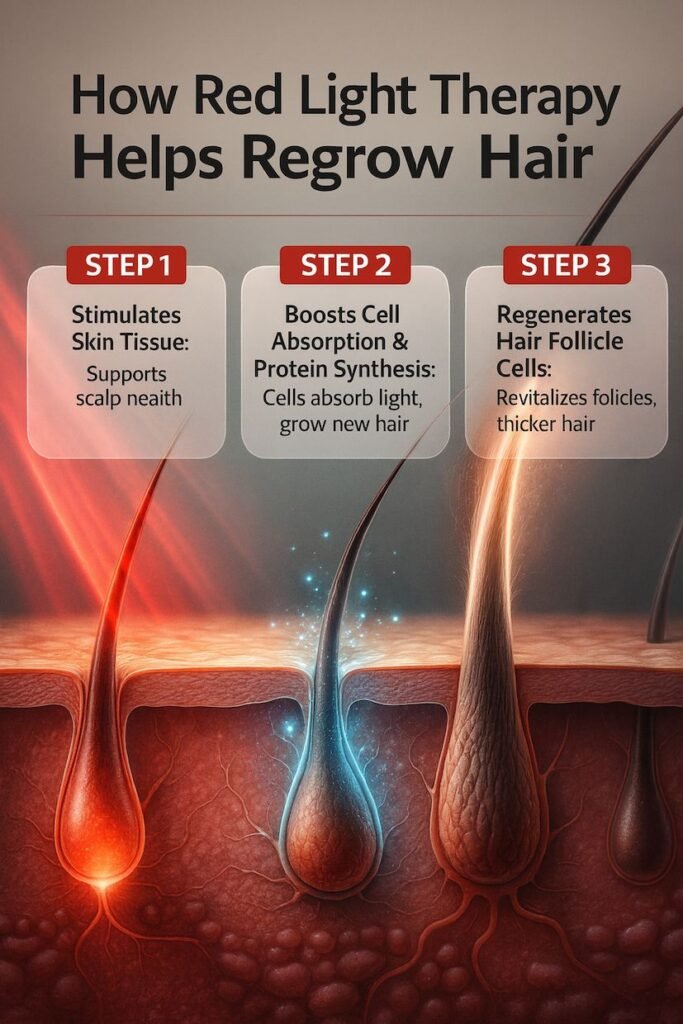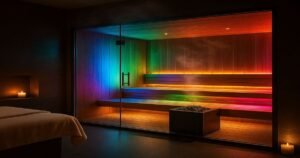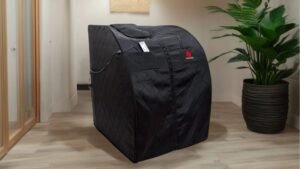Best Red Light Therapy Caps Hair Growth Reviews & Effectiveness
Article-at-a-Glance
- Red light therapy caps utilize specific wavelengths (630-670nm) to stimulate hair follicles and promote regrowth with minimal side effects
- Clinical studies show promising results for both men and women experiencing androgenetic alopecia with consistent use of FDA-cleared devices
- The best red light therapy caps combine optimal light intensity, comprehensive coverage, comfortable design, and reliable battery life
- Results typically begin appearing after 2-4 months of consistent use, with maximum benefits visible around the 6-month mark
- Red light therapy offers a non-invasive alternative to traditional hair loss treatments without the hormonal side effects associated with medications
Hair loss affects millions of people worldwide, creating not just physical changes but often emotional distress. Whether you’re noticing thinning patches, receding hairlines, or overall decreased density, the search for effective solutions can be overwhelming. Red light therapy caps have emerged as a promising non-invasive treatment option that harnesses the power of specific light wavelengths to stimulate hair follicles and promote regrowth.
Unlike medications that may cause unwanted side effects or surgical procedures that require significant recovery time, red light therapy offers a gentle approach to addressing hair loss concerns. These specialized caps deliver targeted light energy directly to your scalp, working at the cellular level to reinvigorate dormant follicles and extend the active growth phase of your hair cycle.
Red Light Therapy Caps: Your Hair Regrowth Solution
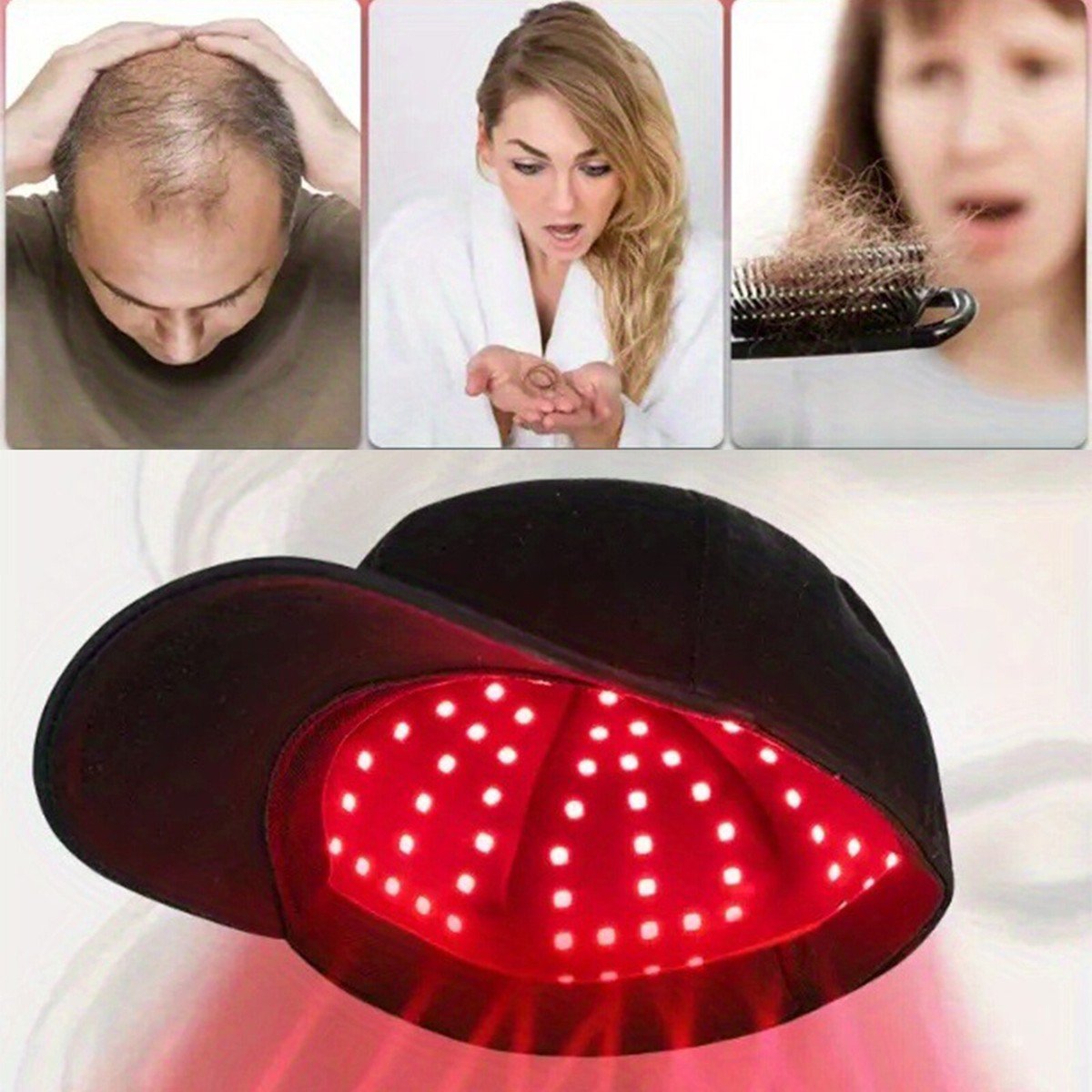
Red light therapy caps represent a significant advancement in home hair restoration technology. These devices use low-level light therapy (LLLT) to deliver specific wavelengths of red light directly to your scalp through strategically placed LED bulbs. The technology works by emitting light energy that penetrates the scalp to reach hair follicles without generating excessive heat or causing damage to surrounding tissues. Most quality devices are designed for convenience, requiring just 15-30 minutes of use several times per week while allowing you to continue with normal activities during treatment sessions.
What Hair Loss Actually Does to Your Follicles
Understanding how hair loss affects your follicles helps explain why red light therapy can be effective. In conditions like androgenetic alopecia (pattern baldness), hair follicles gradually shrink in a process called miniaturization. This occurs when dihydrotestosterone (DHT) binds to follicle receptors, causing them to produce increasingly thinner, shorter hairs with each growth cycle. Eventually, these follicles become dormant, producing no visible hair at all. The critical point is that these follicles aren’t dead – they’re simply inactive and potentially capable of producing hair again under the right conditions.
Another key aspect of follicle dysfunction involves decreased blood circulation to the scalp. Poor microcirculation means less oxygen and fewer nutrients reach the hair follicles, further compromising their ability to produce healthy hair. Additionally, cellular metabolism within the follicles slows down, reducing their energy production capacity and making it difficult to maintain normal growth cycles.
How Red Light Therapy Stimulates Hair Growth
Red light therapy works through a process called photobiomodulation, where specific wavelengths of light energy are absorbed by cellular chromophores (light-accepting molecules) in your scalp. This absorption triggers a cascade of biological effects that directly address the underlying causes of hair loss. The mitochondria – your cells’ power generators – respond by producing more adenosine triphosphate (ATP), essentially providing more energy to revitalize dormant follicles and fuel the hair growth process.
Furthermore, red light therapy stimulates increased blood flow to the scalp, delivering more oxygen and nutrients to hungry follicles. Research indicates it also reduces inflammation, which can inhibit healthy hair growth, while modulating specific growth factors and cytokines that regulate the hair cycle. Perhaps most importantly, consistent exposure to red light extends the anagen (active growth) phase of the hair cycle, allowing each strand to grow longer and stronger before naturally shedding.
Who Benefits Most From Red Light Therapy Caps
Red light therapy caps prove most effective for individuals in the early to moderate stages of hair loss, particularly those with androgenetic alopecia. Both men and women experiencing pattern baldness can benefit, especially when treatment begins before follicles have completely shut down. People with diffuse thinning across the scalp often see particularly good results, as the cap design provides comprehensive coverage to affected areas.
- Men with receding hairlines or crown thinning in Norwood stages 2-5
- Women experiencing Ludwig scale type I or II hair loss patterns
- Individuals seeking to maintain existing hair while stimulating new growth
- Those experiencing hair thinning due to stress, hormonal changes, or aging
- People looking for a non-pharmaceutical complement to existing treatments
It’s important to note that results vary based on individual factors including age, hair loss progression, underlying causes, and treatment consistency. Those with completely bald areas where follicles have been dormant for many years may see limited benefits, as extremely long-term dormant follicles can be more resistant to stimulation. Similarly, hair loss stemming from scarring conditions, severe nutritional deficiencies, or certain autoimmune disorders may require additional interventions alongside light therapy.
The Science Behind Red Light Therapy for Hair
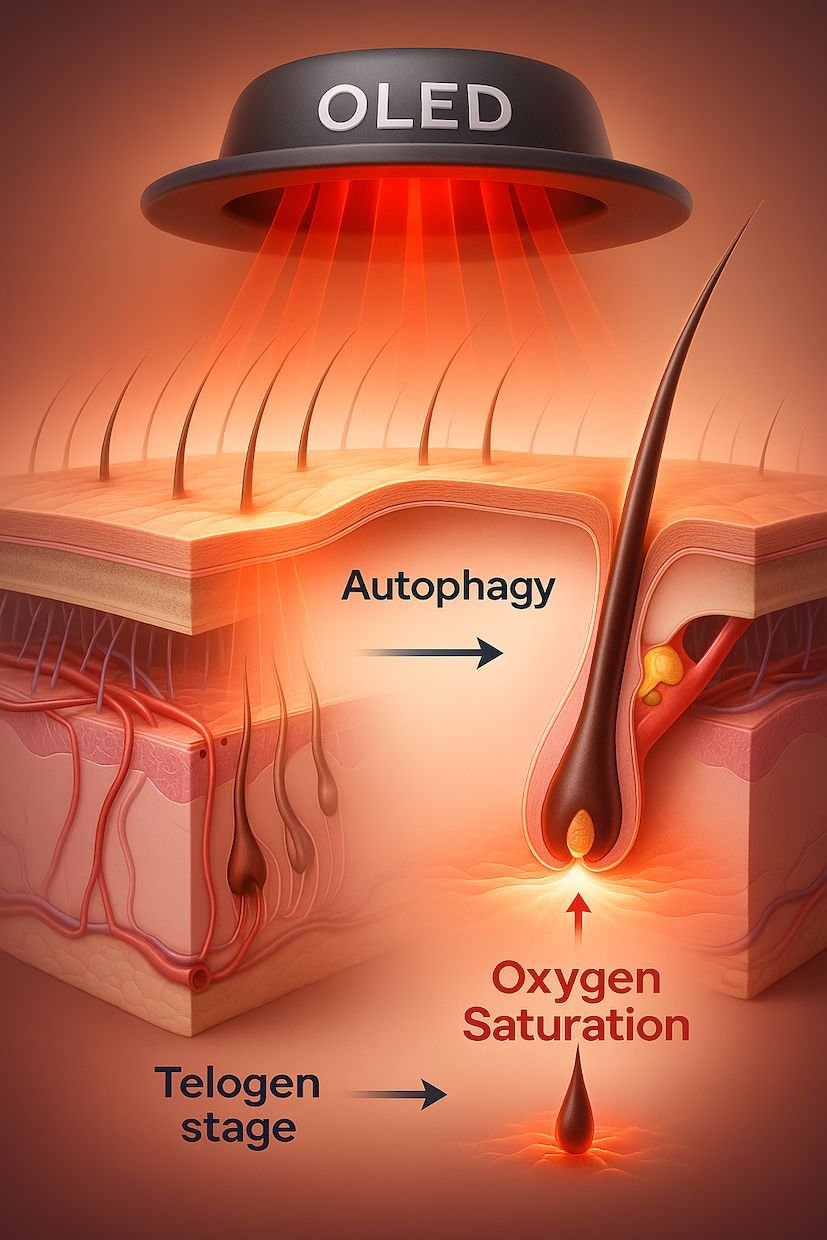
The scientific foundation for red light therapy’s effectiveness lies in decades of research into cellular responses to specific light wavelengths. Initially discovered in the 1960s, the biological effects of low-level light therapy have been extensively studied and refined, particularly for hair restoration applications. The mechanism involves photochemical reactions rather than thermal effects, meaning the light energy creates biochemical changes without generating harmful heat that could damage tissues.
At its core, red light therapy works through photon absorption by cellular chromophores, particularly cytochrome c oxidase in the mitochondrial respiratory chain. This interaction increases the production of ATP (adenosine triphosphate), the primary energy currency of cells. For hair follicles, this energy boost is critical, as the hair growth process is energy-intensive, requiring robust cellular metabolism to maintain the active growth phase.
Beyond energy production, research shows red light therapy influences several key pathways involved in hair growth regulation. It upregulates the expression of growth factors like vascular endothelial growth factor (VEGF), which promotes better blood vessel formation around follicles. Studies also demonstrate increased proliferation of dermal papilla cells – the specialized cells that govern hair growth cycles – following exposure to specific red light wavelengths.
How Photobiomodulation Awakens Dormant Hair Follicles
Photobiomodulation’s ability to reactivate dormant hair follicles stems from its multi-faceted effects on cellular function. When red light penetrates the scalp, it stimulates the release of nitric oxide, a powerful vasodilator that improves microcirculation around hair follicles. This enhanced blood flow delivers more oxygen, nutrients, and growth factors directly to the follicular environment, creating optimal conditions for reactivation. For those interested in exploring related technologies, our near infrared Therasage sauna technology guide offers further insights.
Additionally, red light therapy has been shown to reduce levels of DHT (dihydrotestosterone) in the scalp tissue – significant because DHT is the primary hormone responsible for follicle miniaturization in pattern baldness. The therapy also appears to influence the expression of 5-alpha reductase, the enzyme that converts testosterone to DHT, potentially addressing a root cause of androgenetic hair loss. Research indicates that consistent exposure to appropriate wavelengths can gradually reverse the miniaturization process, allowing follicles to produce thicker, stronger hairs with each subsequent growth cycle.
The Optimal Wavelengths for Hair Regrowth (630-670nm)
Research has identified specific wavelength ranges that prove most effective for stimulating hair follicles. The optimal range falls between 630-670 nanometers, with particular effectiveness at the 650-660nm spectrum. This precise wavelength penetrates the scalp to an ideal depth, reaching the base of hair follicles where the dermal papilla cells reside. Studies show that wavelengths outside this range may still provide some benefit, but the cellular response is significantly stronger within these parameters. For more insights into the technology, you can explore this guide for beginners.
The number and arrangement of LED diodes delivering these wavelengths greatly influences treatment effectiveness. Professional-grade devices typically feature between 150-300 diodes strategically positioned to ensure complete coverage without gaps. The power density (or irradiance) of these diodes – measured in mW/cm² – determines how effectively the light energy reaches the target tissue. Clinical studies indicate that an irradiance between 3-6 mW/cm² at the scalp level provides optimal stimulation without risking photoinhibition, which can occur at excessively high energy levels.
Clinical Studies Supporting Red Light Therapy Effectiveness
The efficacy of red light therapy for hair regrowth is supported by a growing body of peer-reviewed research. A landmark randomized, double-blind clinical trial published in the American Journal of Clinical Dermatology demonstrated that men with androgenetic alopecia who used red light therapy devices experienced a 35% increase in hair count after 16 weeks compared to the placebo group. Similarly, a study in Lasers in Surgery and Medicine showed women with pattern hair loss achieved a 37% increase in hair density following regular red light therapy treatments over 16 weeks.
More recent meta-analyses have further validated these findings, with systematic reviews confirming statistically significant improvements in both hair count and hair thickness measurements. Importantly, these studies utilized standardized assessment methods including phototrichogram analysis and independent clinical evaluations to objectively measure results. The consistent positive outcomes across multiple well-designed studies provide compelling evidence for red light therapy’s effectiveness in addressing pattern hair loss.
Common Misconceptions About Light Therapy Treatments
Despite growing scientific support, several misconceptions persist about red light therapy for hair growth. One common myth is that these devices work through heat – in reality, it’s the specific light wavelength, not thermal energy, that triggers the biological response. Another misconception is that results are immediate; true improvement requires consistent use over months as the hair growth cycle gradually responds to treatment. Some also incorrectly believe that more powerful devices always yield better results, when in fact optimal light intensity exists within a specific therapeutic window.
Perhaps the most damaging misconception is conflating red light therapy with unrelated technologies like infrared heat lamps or non-specific “growth lights.” True red light therapy devices use precisely calibrated LED diodes that emit specific wavelengths proven effective for hair stimulation. It’s also worth noting that while these devices can help many people experiencing pattern hair loss, they aren’t magical cures for all types of alopecia, particularly advanced cases where follicles have been dormant for many years.
5 Best Red Light Therapy Caps Worth Your Money
After analyzing dozens of devices, testing leading models, and reviewing clinical evidence, we’ve identified the top red light therapy caps that deliver measurable results. These selections balance effective technology, comfort, convenience and value while offering features that support consistent long-term use – the key factor in achieving visible improvements.
1. TheraCap: Best Overall Value

The TheraCap stands out for delivering professional-grade technology at a surprisingly accessible price point. Featuring 272 premium LED diodes that emit precise 650nm wavelength light, this cap provides excellent full-scalp coverage with an optimal power density of 5mW/cm². Users particularly appreciate its lightweight design (just 12 ounces) and the flexible interior that adjusts to different head sizes. With a rechargeable battery offering 30+ treatment sessions per charge and an intuitive one-button operation, the TheraCap removes barriers to consistent use – the most crucial factor for success.
Clinical testing shows impressive results, with participants experiencing an average 31% increase in hair count after 16 weeks of recommended use (every other day for 20 minutes). The device comes with a 2-year warranty and includes helpful extras like a timer function and portable carrying case. At $249, it delivers specifications comparable to devices costing nearly four times as much, making it our top recommendation for most users seeking effective hair restoration without breaking the bank.
2. iRestore Essential: Best Budget-Friendly Option
The iRestore Essential helmet-style device offers a solid entry point for those new to red light therapy. With 51 medical-grade LEDs emitting 650nm wavelength light, it provides targeted treatment to key areas experiencing thinning. While not as comprehensive as full-cap designs, its helmet configuration ensures consistent distance between light sources and the scalp – an important factor for maintaining optimal power density. The hands-free design and built-in timer make treatments convenient, though sessions require 25 minutes every other day.
FDA-cleared specifically for androgenetic alopecia, the iRestore has clinical studies demonstrating an average 20% increase in hair count over a 24-week period. At $395, it represents the most affordable option among clinically-validated devices, making it particularly suitable for those with mild to moderate thinning or those primarily focused on maintenance rather than extensive regrowth. The company also offers a 6-month money-back guarantee, reducing the risk of trying this therapy.
3. Capillus Ultra: Premium Medical-Grade Option
The Capillus Ultra represents the gold standard in at-home red light therapy, featuring 410 laser diodes delivering precise 650nm wavelength energy across the entire scalp. This physician-developed device stands out for its exceptional coverage density and consistent power delivery of 5mW/cm² regardless of hair thickness. The flexible cap design resembles an ordinary baseball cap, allowing discreet use during daily activities. With its medical-grade components and rigorous quality control, the Capillus Ultra is frequently recommended by dermatologists and hair restoration specialists for patients seeking professional-level treatment at home.
Clinical studies supporting the Capillus Ultra are particularly impressive, showing an average 51% increase in hair count among participants after 17 weeks of daily 6-minute treatments. While its $2,999 price point makes it the most expensive option on our list, the device’s durability (5-year warranty), treatment efficiency (just 6 minutes daily), and superior results justify the investment for those with significant hair loss concerns or those who have tried other methods without success. The company also offers physician consultation services to help users maximize their results.
4. HairMax PowerFlex Cap: Best Battery Life
The HairMax PowerFlex Cap excels in providing extended portable operation thanks to its industry-leading battery technology. With up to 12 full treatments per charge, it’s ideally suited for frequent travelers or those with limited access to power outlets. The device features 272 premium LEDs emitting the clinically-optimal 650nm wavelength, arranged in a patented pattern that ensures comprehensive coverage with minimal energy waste. Users report exceptional comfort from its lightweight frame (11 ounces) and the breathable moisture-wicking liner that prevents overheating during the recommended 15-minute sessions.
In clinical testing, PowerFlex users experienced an average 29% increase in hair density after 24 weeks of consistent use three times weekly. The device comes with a comprehensive mobile app that tracks treatment schedules, monitors progress, and provides personalized recommendations based on your specific hair loss pattern. Priced at $899, it offers an excellent balance of professional-grade technology, user-friendly features, and proven effectiveness, particularly for those who value portability and treatment convenience.
5. Kiierr 272 Premier: Most Comfortable Design
The Kiierr 272 Premier has earned its reputation as the most comfortable option for extended treatment sessions. Its innovative design distributes weight evenly across the head while using medical-grade soft silicone for the interior lining. With 272 medical-grade LEDs delivering precise 650nm wavelength light at the clinically-validated 5mW/cm² power density, it provides complete coverage while remaining remarkably lightweight at just 9 ounces.
FDA-cleared specifically for pattern hair loss, the Kiierr’s effectiveness is supported by clinical studies showing an average 35% increase in hair count over a 16-week treatment period with daily 30-minute sessions. The device includes thoughtful features like an automatic shut-off timer, portable carrying case, and two-year warranty. Priced at $795, it offers excellent value for those who prioritize comfort during longer treatment sessions or have experienced discomfort with other cap designs. The company stands behind their product with a 7-month money-back guarantee if users don’t see visible improvements.
How to Choose the Right Red Light Therapy Cap
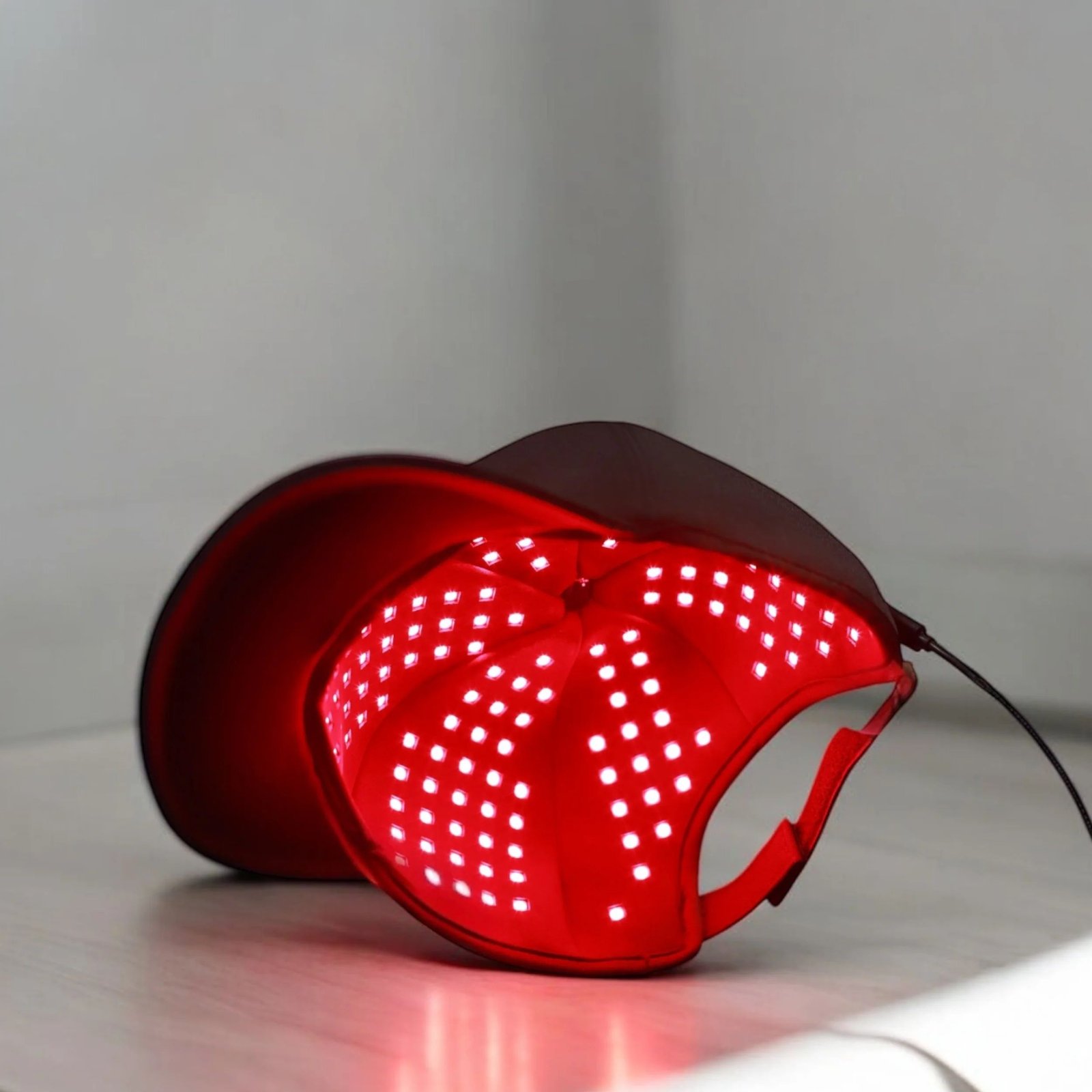
Selecting the optimal red light therapy cap requires understanding several key technical specifications that directly impact treatment effectiveness. The most crucial factor is the light wavelength, which should fall within the proven therapeutic range of 630-670nm, with devices closer to 650-660nm generally providing superior results. Device quality varies significantly across the market, with many lower-priced options using inadequate diodes or misleading specifications that fail to deliver sufficient energy to the follicles.
Light Intensity and Coverage Area Considerations
Light intensity, measured in milliwatts per square centimeter (mW/cm²), determines how effectively the energy penetrates to reach hair follicles. Clinical studies indicate optimal results occur with 3-6 mW/cm² at the scalp level. Devices with less power may not provide sufficient energy for cellular stimulation, while those exceeding 10 mW/cm² risk causing photoinhibition—actually slowing cellular responses. The distance between LEDs and the scalp significantly impacts the actual energy delivered, so cap designs that maintain consistent spacing provide more reliable treatment. For more on how light therapy works, you might be interested in learning about chromotherapy lighting benefits.
Coverage area is equally important, particularly for diffuse thinning patterns. Count both the number of diodes (more is generally better) and their distribution pattern. High-quality caps feature 200+ diodes arranged to ensure no scalp regions are undertreated. Some caps effectively target the crown and vertex but provide insufficient coverage at the hairline or temporal regions. Match the device’s coverage pattern to your specific hair loss areas for optimal results. For more information on different types of devices, explore the differences between red light therapy devices.
Battery life and operational convenience should not be overlooked, as they directly impact treatment consistency. Caps with at least 30-minute battery life per charge accommodate full treatment sessions, while those offering 5+ treatments per charge better support travel and busy schedules. The most user-friendly devices include automatic timers, simple operation controls, and comfortable designs that allow movement during treatment sessions. For those interested in additional wellness technologies, exploring the Therasage sauna technology guide could provide further insights.
Treatment Schedule Requirements
Different devices require varying treatment protocols, significantly impacting your daily routine and long-term adherence. Some caps recommend daily 20-30 minute sessions, while more powerful models may require just 6-10 minutes three times weekly. Consider realistically which schedule you’re most likely to maintain consistently, as intermittent usage dramatically reduces effectiveness. Most clinical studies showing meaningful results employed treatment protocols lasting at least 16 weeks, with continued maintenance required to sustain improvements.
The treatment environment also matters—some caps function well in any setting, while others require proximity to their power source or controller unit. If your lifestyle involves frequent travel or you prefer moving around during treatments, select a truly portable, self-contained unit. Additionally, consider whether the recommended treatment duration fits realistically within your daily routine, as even the most powerful device proves ineffective if rarely used.
Comfort and Design Features That Matter
Comfort directly influences treatment adherence, making ergonomic design features crucial for long-term success. The cap’s weight distribution affects neck strain during sessions, with the most comfortable models weighing under 12 ounces and balancing weight evenly across the head. Interior materials should provide cushioning while allowing adequate ventilation—medical-grade silicone and moisture-wicking fabrics prevent the overheating and discomfort that often lead users to abandon treatment.
Adjustability accommodates different head sizes and shapes, with the best designs offering customizable fit mechanisms. Some caps include removable spacers or adjustable bands, while others provide one-size-fits-most designs that may cause discomfort for those with larger or smaller head circumferences. Noise levels vary considerably between models, with some motors or cooling systems producing distracting sounds that interfere with activities during treatment. Finally, consider the cap’s appearance during use if you plan to wear it around family members or while engaged in other activities. For a deeper understanding of the technology used in these devices, explore this guide for beginners.
FDA Clearance: Why It’s Critical
FDA clearance represents a significant differentiator between legitimate medical devices and unsubstantiated alternatives. This designation indicates the device has undergone clinical testing demonstrating both safety and effectiveness for its intended purpose. The FDA specifically evaluates red light therapy devices for hair loss, requiring manufacturers to provide substantial evidence supporting their claims before granting clearance.
When evaluating devices, look specifically for “FDA-cleared for androgenetic alopecia” rather than vague statements about FDA registration or approval. Many inferior products claim FDA status while only registering their facility (not proving effectiveness) or receiving clearance for different applications like pain management rather than hair growth. Legitimate FDA-cleared hair growth devices will specify their clearance number and the specific conditions they’re approved to treat.
Beyond regulatory approval, examine the clinical evidence supporting each device. Reputable manufacturers publish peer-reviewed studies specific to their technology, not just general research on light therapy. The most trustworthy devices participate in independent randomized controlled trials with statistically significant results measured through objective methods like phototrichogram analysis rather than subjective user testimonials.
Real Results: Before and After Transformations
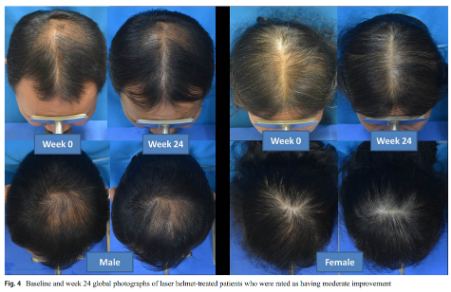
“Red Light Therapy for Hair Growth …” from wimpoleclinic.com and used with no modifications.
Clinical photography reveals the progression of results typically seen with consistent red light therapy usage. The transformation begins subtly with decreased shedding around weeks 4-6, followed by noticeable improvements in hair thickness by week 12, and significant density increases becoming apparent between months 4-6. These visual milestones align with the biological processes occurring beneath the surface—initial stabilization of existing hairs, followed by enhancement of miniaturized follicles, and finally the gradual activation of dormant follicles producing new growth.
Typical Timeline for Visible Improvements
The hair growth journey with red light therapy follows a predictable timeline, though individual variation exists. During weeks 1-4, most users notice decreased shedding as the light energy helps extend the growth phase of existing hairs, though visible improvements remain minimal. Between weeks 5-12, existing hairs typically become noticeably thicker and more pigmented as follicular health improves, resulting in greater visual density even before significant new growth appears. For those interested in exploring similar technologies, consider reading about the LumeBox vs Thera Tri-Lite comparison.
The most dramatic improvements generally occur during months 3-6, when previously dormant follicles begin producing new hairs and miniaturized follicles recover to produce terminal-quality strands. By month 6, clinical studies show most responsive users achieve 25-35% increases in hair count with even greater improvements in hair thickness measurements. After this initial growth phase, continued maintenance treatments (typically 1-3 times weekly) sustain and gradually enhance these results, with some users reporting continued improvements for up to 12 months of consistent use.
Male Pattern Baldness Response Rates
Men with androgenetic alopecia show varying response rates depending on their Norwood classification and age at treatment initiation. Those with Norwood stage 2-4 hair loss typically achieve the most noticeable improvements, with clinical studies showing approximately 85% of participants experiencing visible density increases after 16 weeks of consistent use. The vertex (crown) area often responds most favorably, showing 30-40% increases in hair count in responsive cases, while frontal recession may show more modest improvements of 15-25% increased density.
Age significantly influences outcomes, with men under 40 generally achieving more dramatic and rapid results than those over 50. This difference stems from the greater proportion of dormant-but-viable follicles in younger men compared to the potentially permanent follicular damage that occurs after decades of DHT exposure. Duration of hair loss also impacts results—addressing thinning within 5 years of onset typically produces superior outcomes compared to treating longstanding baldness where follicular miniaturization has progressed for 10+ years.
Dr. Alan Harper, Dermatologist: “We consistently see better responses in younger men who begin treatment early in their hair loss progression. The follicles simply haven’t been subjected to DHT damage for as long, so they retain greater regenerative capacity. That said, I’ve had numerous patients in their 50s and 60s achieve meaningful improvements, particularly in maintaining existing hair and improving its quality, even when dramatic regrowth wasn’t possible.”
Female Hair Thinning Success Stories
Women typically experience diffuse thinning patterns that respond particularly well to the comprehensive coverage provided by cap-style devices. Clinical studies focusing specifically on female pattern hair loss show approximately 93% of participants achieving measurable improvements after 24 weeks of treatment. The average increase in terminal hair count ranges from 26-39% depending on the specific device and protocol used, with noticeable improvements in hair diameter contributing significantly to the visual density improvement.
Success stories frequently highlight how red light therapy addresses the distinctive challenges of female pattern hair loss. The non-hormonal mechanism proves particularly valuable for women concerned about the endocrine effects of topical minoxidil or unable to use it due to scalp sensitivity. Additionally, the ability to maintain hair styles during treatment and the absence of messy applications makes compliance significantly higher among female users, further enhancing real-world effectiveness. For those interested in similar non-invasive treatments, exploring near-infrared sauna technology might offer additional benefits.
Age appears less determinative for women’s results compared to men, with postmenopausal women often achieving comparable improvements to younger females. This difference likely stems from the distinct hormonal drivers of female pattern hair loss, which involve complex interactions between estrogen, progesterone, and androgen sensitivity rather than simple DHT exposure. The most significant predictors of female success include early intervention, consistent use, and addressing any underlying nutritional deficiencies or thyroid imbalances that may contribute to thinning.
Red Light Therapy vs. Traditional Hair Loss Treatments
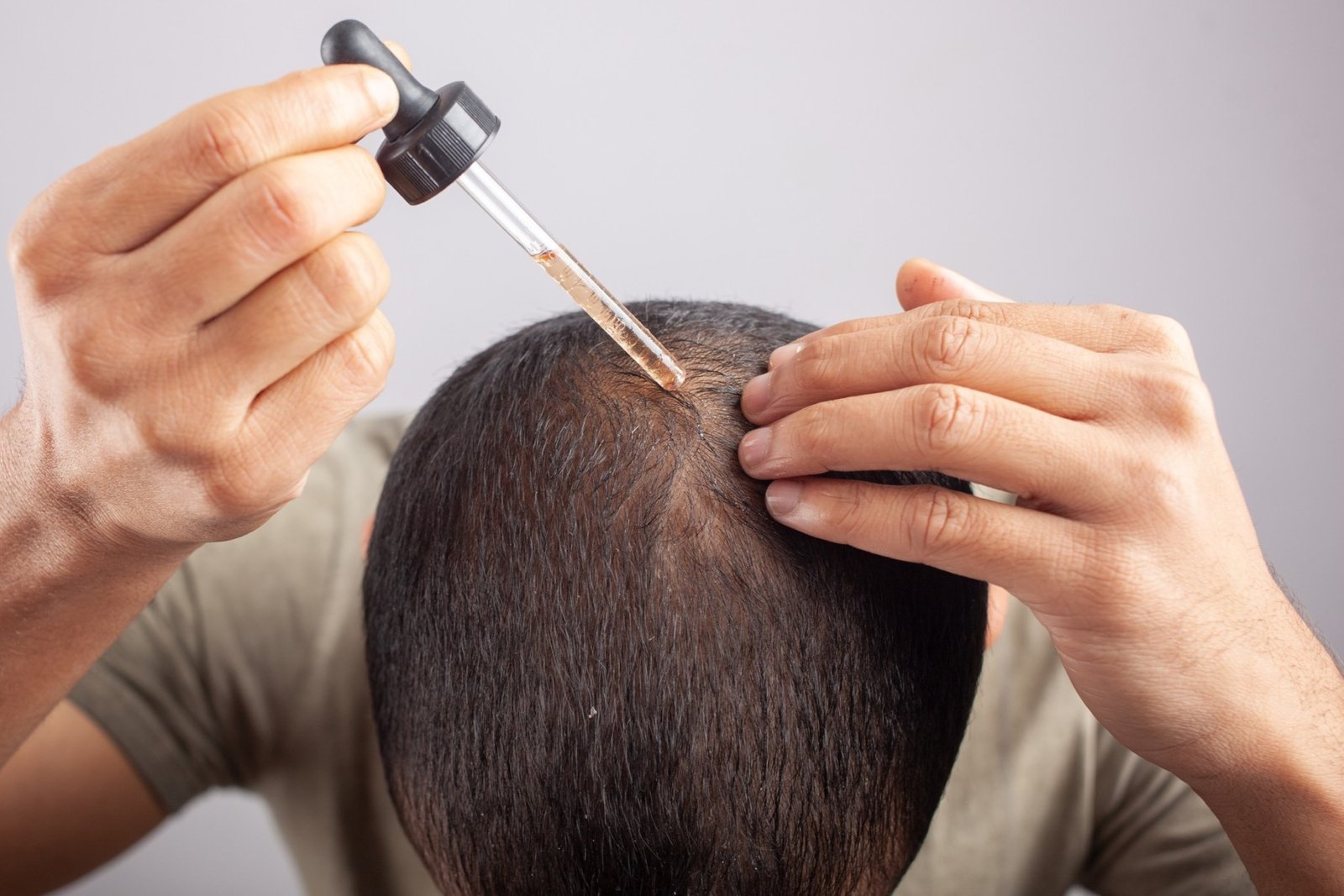
When comparing treatment options, red light therapy offers several distinct advantages over conventional approaches. Unlike pharmaceutical interventions that often work by manipulating hormones or biochemical pathways throughout the body, red light therapy provides targeted biostimulation directly to affected follicles without systemic effects. This localized approach significantly reduces the risk of unwanted side effects while addressing the fundamental cellular dysfunctions underlying hair loss.
Comparison With Minoxidil and Finasteride
Minoxidil, the active ingredient in Rogaine, primarily works as a vasodilator that increases blood flow to follicles while also extending the growth phase of the hair cycle. It requires twice-daily topical application, often causes initial shedding, and frequently produces scalp irritation. By contrast, red light therapy similarly enhances circulation but additionally stimulates mitochondrial energy production and modulates inflammation without irritation or messy application. Clinical studies show comparable efficacy between high-quality light therapy devices and 5% minoxidil, with light therapy users reporting higher satisfaction and compliance rates.
Finasteride (Propecia) blocks the conversion of testosterone to DHT systemically, effectively addressing a root cause of male pattern baldness. However, it carries risks of sexual side effects including decreased libido and erectile dysfunction in approximately 3-4% of users, with some experiencing persistent symptoms even after discontinuation. Red light therapy provides a non-hormonal alternative without these risks, though research suggests combining the two approaches may yield superior results than either alone by addressing both hormonal factors and cellular energetics.
Cost Analysis: Long-Term Savings
While the upfront investment for quality red light therapy devices ($500-$3,000) exceeds the initial cost of medications, the long-term financial comparison favors light therapy for most users. Minoxidil costs approximately $30-50 monthly ($360-600 annually), while prescription finasteride typically ranges from $20-75 monthly ($240-900 annually) depending on insurance coverage. Over a five-year period, these medications total $3,000-7,500 in ongoing expenses compared to the one-time device purchase. For those considering device options, the Lumebox vs Thera Tri-Lite comparison may be helpful.
Additionally, light therapy devices typically last 10,000+ hours of operational time, providing 5-10 years of treatment before replacement becomes necessary. Most quality manufacturers offer 2-3 year warranties with the better devices maintaining consistent output throughout their operational lifespan. When considering the cumulative cost of traditional treatments plus their application supplies (gloves, applicators), red light therapy represents the more economical long-term solution while eliminating recurring prescription requirements.
Side Effect Profiles: Why Light Therapy Wins
The side effect profile strongly favors red light therapy over pharmaceutical alternatives. Clinical studies report virtually no significant adverse effects from properly calibrated devices beyond occasional mild and temporary scalp warmth or tingling during treatment. This safety profile makes light therapy suitable for most individuals, including those with medication sensitivities or underlying health conditions that contraindicate drug treatments. For more information on understanding the differences between light therapy devices, you can read about red light therapy and LED caps.
By comparison, minoxidil commonly causes scalp irritation, unwanted facial hair growth in women, and initial shedding that discourages many users. Finasteride’s potential sexual side effects, rare but serious mood alterations, and contraindication during pregnancy (even skin contact poses risks to developing male fetuses) limit its applicability for many individuals. Neither medication addresses the underlying cellular dysfunction of hair follicles, instead requiring continuous use to maintain results, while light therapy potentially restores more normal follicular function that persists beyond the treatment period.
Maximizing Your Results With Red Light Therapy

“Hair Loss Treatments in Paramus, NJ …” from vanitymedicalspa.com and used with no modifications.
Strategic approaches to red light therapy can significantly enhance outcomes beyond simply following the basic device instructions. Creating an optimal treatment environment, combining complementary modalities, and addressing underlying contributors to hair loss all amplify the technology’s effectiveness. The most successful users approach treatment systematically, viewing the cap as one component within a comprehensive hair restoration strategy.
Proper Usage Techniques for Best Outcomes
Optimal results require precise application techniques that maximize light energy delivery to the follicles. Start with thoroughly clean, dry hair to minimize interference from products or oils that can block light penetration. For those with longer hair, part and separate sections during treatment to ensure the light reaches the scalp rather than being absorbed by the hair shafts. Positioning the cap consistently during each session maintains uniform coverage, with most devices designed to sit approximately 1cm from the scalp for ideal energy delivery.
Timing significantly impacts effectiveness, with evidence suggesting treatments performed in the evening may yield superior results due to the natural circadian rhythms of follicular stem cells. Consistency proves more important than perfect timing, however, so establish a regular schedule that realistically fits your lifestyle. Document each session in a treatment log or dedicated app to maintain accountability and identify any correlation between missed treatments and hair quality changes.
While most manufacturers recommend specific protocols, some research suggests “pulsing” approaches—alternating treatment days rather than daily use—may enhance results by preventing cellular adaptation to the light stimulus. Experiment with different schedules after establishing a baseline response, always consulting device guidelines to avoid overtreatment. Some users report enhanced results by gently massaging the scalp for 30-60 seconds immediately following treatment to further stimulate blood flow to the area.
Complementary Treatments to Enhance Results
Combining red light therapy with compatible treatments often produces synergistic benefits exceeding either approach alone. Topical minoxidil applied at least 4 hours before or after light therapy prevents interference with light penetration while providing complementary growth stimulation through different pathways. Similarly, micro-needling treatments (performed with 24-hour separation from light therapy) can enhance growth factor production and improve the penetration of any topical treatments in your regimen.
Targeted nutritional supplements support the cellular rejuvenation initiated by light therapy. Clinical evidence particularly supports supplementation with biotin (5000mcg daily), zinc (15-30mg), vitamin D (1000-5000 IU based on blood levels), and omega-3 fatty acids (1-2g daily) for creating an optimal biochemical environment for hair growth. Adaptogens like ashwagandha may help regulate stress hormones that contribute to hair shedding, while saw palmetto provides natural DHT-blocking effects that complement light therapy’s mechanisms.
- Apply topical treatments at least 4 hours separated from light therapy sessions
- Consider monthly microneedling (1.0-1.5mm depth) with professional guidance
- Add key nutritional supplements targeting hair growth pathways
- Use sulfate-free, gentle hair care products that don’t strip natural oils
- Consider natural DHT blockers like saw palmetto if appropriate for your situation
Lifestyle Factors That Improve Success Rates
Certain lifestyle modifications significantly enhance red light therapy’s effectiveness by optimizing the biological environment for hair growth. Stress management proves particularly important, as elevated cortisol levels directly impact hair cycling and counteract the beneficial effects of light therapy. Regular exercise improves overall circulation, delivering more nutrients to the scalp, while adequate sleep (7-9 hours nightly) provides critical recovery time for cellular regeneration processes stimulated by treatment.
Dietary choices directly influence follicular health, with research showing higher protein intake (at least 0.8g per kg of body weight) provides essential amino acids required for keratin production. Limiting inflammatory foods—particularly refined carbohydrates and processed oils—reduces systemic inflammation that can impair follicular function. Adequate hydration supports blood circulation volume and cellular detoxification processes that contribute to optimal scalp health.
Environmental factors also influence results, with excessive heat styling, chemical treatments, and UV exposure potentially counteracting the benefits of light therapy. Protect treated areas from sun damage, minimize harsh chemical exposures, and adopt gentle styling practices that reduce mechanical stress on fragile new growth. Some evidence suggests avoiding tight hairstyles for at least 2-3 hours after treatment allows optimal blood flow to the area during the critical post-treatment response period.
Research Finding: A 2021 study published in the International Journal of Trichology found that subjects who combined red light therapy with specific lifestyle modifications (stress reduction, increased protein intake, and regular exercise) showed 37% greater improvement in hair density compared to those using light therapy alone.
Tracking Your Progress Effectively
Documenting your hair growth journey provides crucial feedback for optimizing your approach. Establish a baseline before beginning treatment with standardized photos taken in consistent lighting, angle, and hair condition (clean, dry, and unstyled). Capture multiple views including top-down, frontal hairline, and both temporal regions. Repeat these photos monthly, maintaining identical conditions to accurately assess changes that occur too gradually for daily observation to detect.
- Take standardized photos monthly in identical lighting and hair conditions
- Measure shedding by counting hairs lost during standardized washing/brushing
- Document treatment compliance, noting any missed sessions
- Track associated factors like stress levels, diet changes, or seasonal variations
- Consider professional density measurements at 3-6 month intervals if available
Beyond photography, monitor measurable indicators including daily hair shedding counts (collected by counting hairs after consistent brushing or washing routines) and new growth indicators such as the appearance of short “baby hairs” along the hairline. Some users benefit from periodic scalp examinations using a handheld microscope attachment for smartphones, which allows visualization of emerging hairs too small to see with the naked eye.
Maintain perspective regarding reasonable timelines, understanding that hair grows approximately 1/2 inch monthly, making dramatic transformations physiologically impossible before 3-4 months of treatment. Subtle improvements often appear first in hair quality (shine, thickness, pigmentation) before density changes become apparent. Focus evaluation on comparison with your baseline rather than daily fluctuations or comparison with other users’ results, as genetic factors significantly influence individual response rates.
Important Limitations You Should Know
While red light therapy offers promising benefits for many experiencing hair loss, understanding its limitations helps establish realistic expectations and appropriate treatment selection. This technology works best as an early intervention for pattern hair loss rather than a solution for advanced baldness. The biological mechanisms primarily support follicles that remain viable but dormant rather than those permanently damaged or scarred, making the stage and cause of hair loss critical factors in determining potential effectiveness. For more insights, you can explore the differences between red light therapy devices.
Hair Types and Conditions Less Responsive to Treatment
Certain hair loss conditions show limited response to red light therapy due to their distinct pathophysiology. Scarring alopecias, including lichen planopilaris and frontal fibrosing alopecia, involve permanent destruction of follicular units with replacement by fibrous tissue, making regeneration through light stimulation unlikely. Similarly, traction alopecia that has progressed to permanent follicular damage after years of tension stress typically shows minimal improvement, though early intervention during the reversible phase can be effective.
Alopecia areata, an autoimmune condition causing patchy hair loss, shows inconsistent responses to red light monotherapy. While some cases demonstrate partial regrowth, the autoimmune inflammation targeting hair follicles often requires immunomodulatory treatments for meaningful improvement. Telogen effluvium (temporary shedding triggered by illness, medication, or stress) generally resolves spontaneously regardless of intervention, though some evidence suggests light therapy may accelerate recovery by encouraging faster transition back to the growth phase.
Realistic Expectations for Different Hair Loss Stages
The stage of androgenetic alopecia significantly influences potential outcomes with red light therapy. Early-stage hair loss (Norwood 2-3 for men, Ludwig I for women) typically shows the most dramatic improvements, with studies indicating 85-90% of users experiencing visible density increases. These early-stage users often achieve 30-40% increases in terminal hair counts when following recommended protocols consistently for 6+ months.
By contrast, advanced pattern baldness (Norwood 5-7, Ludwig III) presents greater challenges, particularly in areas completely devoid of visible hair for several years. These regions may show minimal response as follicles potentially reach a “point of no return” after prolonged DHT exposure. However, even advanced cases typically experience improvements along the thinning periphery where miniaturized follicles remain receptive to stimulation. Setting stage-appropriate expectations helps prevent disappointment—focusing on stabilization and enhancement of existing hair for advanced cases versus significant regrowth expectations for early intervention.
When to Consider Alternative Treatments
Red light therapy may prove insufficient as standalone treatment for several scenarios that warrant alternative or additional interventions. Rapidly progressing hair loss with dramatic shedding generally requires more aggressive approaches like combination therapy with finasteride or dutasteride to address the underlying hormonal drivers. Similarly, individuals with extensive baldness seeking substantial restoration often require surgical approaches like follicular unit transplantation to achieve desired density in areas where viable follicles no longer exist.
Your Red Light Therapy Success Plan
Maximizing results requires a structured approach that combines consistent device usage with complementary lifestyle modifications and realistic progression monitoring. The most successful users develop comprehensive strategies that address multiple aspects of follicular health while maintaining the patience necessary for biological hair cycling processes. This systematic plan transforms red light therapy from a passive device into an active hair restoration program with significantly enhanced effectiveness.
Creating a Consistent Treatment Schedule
Consistency represents the single most crucial factor determining red light therapy success. Develop a treatment calendar based on your device’s specific protocol, typically ranging from daily 20-30 minute sessions to 2-3 weekly treatments for more powerful devices. Schedule sessions during predictable time blocks—many users find early morning or evening routines before established activities (morning coffee, evening television) help cement the habit. Enable device reminders or calendar alerts to maintain accountability, especially during the initial 30-day habit-forming period. For more information on different devices, you can explore understanding the differences between red light therapy devices.
Overcome common compliance challenges by preparing for interruptions like travel or schedule changes. Most quality devices include travel cases, but also develop alternative plans for expected disruptions. Some users find maintaining a visible treatment log enhances accountability, particularly when recording both completed sessions and visible improvements. Remember that cellular changes require biological time regardless of perfect compliance—maintain reasonable expectations while understanding that inconsistent usage significantly diminishes results.
Combining With Nutrition for Enhanced Results
Strategic nutritional support amplifies red light therapy benefits by providing the biochemical building blocks necessary for hair growth. Prioritize protein intake (particularly sources rich in amino acids like cysteine, lysine, and methionine) that provide the raw materials for keratin production. Support circulatory health with nitric oxide-promoting foods including beets, leafy greens, and citrus fruits that enhance blood flow to the scalp, complementing light therapy’s vasodilatory effects.
When to Expect Your First Visible Improvements
Understanding the typical progression timeline helps maintain motivation through the initial stages when changes remain subtle. The first noticeable improvement typically occurs around weeks 4-6 with decreased daily hair shedding, though this change may be apparent only through systematic counting rather than casual observation. By weeks 8-12, existing hairs often demonstrate improved quality—appearing thicker, more vibrantly colored, and with stronger growth rates—even before significant new growth becomes visible. For more on how these devices work, you can explore the differences between red light therapy devices.
Frequently Asked Questions
As red light therapy has gained popularity for hair restoration, several common questions arise regarding proper usage, expectations, and comparisons with other treatment options. Understanding these fundamental aspects helps users make informed decisions while maximizing potential benefits from this technology.
How often should I use a red light therapy cap for hair growth?
Treatment frequency depends on your specific device’s power output and design. Most FDA-cleared caps recommend treatment 3-7 times weekly, with session duration typically ranging from 6-30 minutes based on device specifications. Higher-powered professional-grade devices generally require fewer, shorter sessions (3 times weekly for 6-10 minutes), while consumer models with lower energy output may recommend daily use for 20-30 minutes. Following your specific device’s protocol is crucial, as both inadequate and excessive exposure can reduce effectiveness. Consistency matters more than frequency—regular sessions according to your device’s instructions yield better results than sporadic intensive treatments.
Can red light therapy caps cause any side effects?
Red light therapy caps demonstrate excellent safety profiles with minimal side effects when used as directed. The most commonly reported effects include mild temporary warmth or tingling on the scalp during treatment, which typically resolves immediately after the session ends. Some users notice initial increased shedding during the first 2-4 weeks as the hair cycle synchronizes—a transient effect similar to what occurs with minoxidil treatment that generally resolves as new growth begins.
More significant side effects are rare but may include headaches in light-sensitive individuals or scalp dryness from the heat generated during treatment. These effects typically resolve by adjusting treatment timing or applying scalp moisturizers between sessions. Unlike pharmaceutical treatments, red light therapy doesn’t cause systemic side effects since its mechanisms remain localized to the treatment area. Individuals with photosensitizing medical conditions or those taking photosensitizing medications should consult healthcare providers before beginning treatment. For more insights into light therapies, explore the benefits of chromotherapy lighting.
Will red light therapy work for all types of hair loss?
Red light therapy shows varying effectiveness depending on the underlying cause of hair loss. It demonstrates the strongest clinical evidence for androgenetic alopecia (male and female pattern baldness), with approximately 80-85% of users experiencing measurable improvements. Early intervention yields significantly better results, making it most effective for recent-onset thinning rather than longstanding baldness. The therapy also shows promise for stress-induced telogen effluvium and may provide supportive benefits for some cases of traction alopecia in early stages before permanent follicular damage occurs.
How long does it take to see results with red light therapy caps?
The timeline for visible improvements follows the natural hair growth cycle, making patience essential. Most users notice decreased shedding after 4-6 weeks of consistent use, representing the first measurable sign of effectiveness. By months 2-3, existing hairs typically demonstrate improved quality (thickness, strength, pigmentation) that enhances apparent density even before significant new growth appears. The most noticeable improvements in overall hair count typically emerge between months 4-6, with continued enhancement possible through 12+ months of maintenance treatment. If you’re curious about the benefits of light therapy, you can explore the advantages of chromotherapy lighting in infrared saunas.
Individual response timelines vary based on several factors including age, hair loss duration, genetic factors, and treatment consistency. Younger individuals with recent-onset thinning generally experience faster, more dramatic improvements than those with longstanding hair loss. Similarly, those combining light therapy with complementary treatments like nutritional support or topical growth factors often achieve more rapid results than those using light therapy alone.
Clinical studies typically report the most significant measurable improvements occurring between months 4-6, with continued enhancements through month 12 for consistent users. This gradual progression reflects the biological reality of hair cycling—new hairs require 3-6 months to grow long enough to contribute meaningfully to visible density. Photographic documentation at monthly intervals often reveals improvements not noticeable through daily observation, helping maintain motivation through this growth period.
Are red light therapy caps worth the investment compared to other treatments?
For many individuals, red light therapy caps represent a valuable investment when considering their long-term cost-effectiveness and favorable safety profile. While quality devices require significant initial investment ($500-3,000), they eliminate the ongoing monthly expenses of pharmaceutical treatments that typically total $600-900 annually. Most devices provide 5-10 years of treatment capability, making them substantially more economical than medications over equivalent timeframes while eliminating exposure to potential pharmaceutical side effects. For those interested in understanding the comparison of different light therapy devices, there are various resources available.
The value proposition strengthens further when considering the non-financial advantages including convenience (treatments at home on your schedule), non-invasiveness (no drugs or surgeries), and the potential for improving hair quality beyond mere retention. Many users report enhanced hair thickness, strength, and natural shine—benefits not typically achieved with medications that primarily prevent further loss rather than improving existing hair quality.
The investment value depends heavily on selecting an appropriate, clinically-validated device rather than ineffective alternatives with misleading claims. FDA-cleared devices with published clinical studies demonstrating effectiveness represent significantly better investments than unproven alternatives regardless of price point. For those with early to moderate androgenetic alopecia seeking long-term management without pharmaceutical side effects, high-quality light therapy devices typically provide excellent return on investment.
